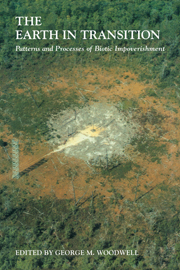Book contents
- Frontmatter
- Contents
- Preface
- Acknowledgments
- List of Contributors
- Part I Global Change and the Patterns of Impoverishment
- Part II Chronic Disturbance and Natural Ecosystems: Forests
- Part III Chronic Disturbance and Natural Ecosystems: Woodlands, Grasslands, and Tundra
- Part IV Chronic Disturbance and Natural Ecosystems: Aquatic and Emergent Ecosystems
- 18 Changes in a Red Sea Coral Community Structure: A Long-Term Case History Study
- 19 Are Deep-Sea Communities Resilient?
- 20 Species Dominance–Diversity Patterns in Oceanic Communities
- 21 Natural and Anthropogenically Imposed Limitations to Biotic Richness in Fresh Waters
- 22 Human Impacts on the South Florida Wetlands: The Everglades and Big Cypress Swamp
- 23 The Impoverishment of Aquatic Communities by Smelter Activities near Sudbury, Canada
- 24 Biotic Impoverishment: Effects of Anthropogenic Stress
- Part V Conclusion: Steps toward a World That Runs Itself
- Name Index
- Subject Index
23 - The Impoverishment of Aquatic Communities by Smelter Activities near Sudbury, Canada
Published online by Cambridge University Press: 24 November 2009
- Frontmatter
- Contents
- Preface
- Acknowledgments
- List of Contributors
- Part I Global Change and the Patterns of Impoverishment
- Part II Chronic Disturbance and Natural Ecosystems: Forests
- Part III Chronic Disturbance and Natural Ecosystems: Woodlands, Grasslands, and Tundra
- Part IV Chronic Disturbance and Natural Ecosystems: Aquatic and Emergent Ecosystems
- 18 Changes in a Red Sea Coral Community Structure: A Long-Term Case History Study
- 19 Are Deep-Sea Communities Resilient?
- 20 Species Dominance–Diversity Patterns in Oceanic Communities
- 21 Natural and Anthropogenically Imposed Limitations to Biotic Richness in Fresh Waters
- 22 Human Impacts on the South Florida Wetlands: The Everglades and Big Cypress Swamp
- 23 The Impoverishment of Aquatic Communities by Smelter Activities near Sudbury, Canada
- 24 Biotic Impoverishment: Effects of Anthropogenic Stress
- Part V Conclusion: Steps toward a World That Runs Itself
- Name Index
- Subject Index
Summary
Editor's Note: The landscape around Sudbury, Ontario, has been devastated over several decades by the gaseous emissions of smelters. The extent of the devastation is difficult to define, but forests have been destroyed by air pollution and prevented from recovering over an area of more than a hundred square miles. The cause is oxides of sulphur and heavy metals emitted over decades from a series of smelting operations. Lakes and streams have been affected as well.
Yan and Welbourn address the problem of defining the patterns of changes in plant and animal communities of lakes and ponds affected by air-borne pollutants 13 km from the smelter. Surprisingly enough, the effects, although cumulative, are reversible, at least in part. They are faithful to patterns reported elsewhere: the small-bodied, rapid reproducers are more resistant; the large-bodied are commonly more vulnerable. Food webs are abridged, fish populations lost, arid certain populations explode in response to removal of competitors. So the effects present an interesting mixture of direct effects of toxins, including aluminum washed off the acidified land, and indirect effects due to changes in predator or consumer pressure.
The transitions are all in the direction of steepening the dominance/diversity curves by concentrating production in one or a few species. The impoverishment leads to increased vulnerability to further disturbance. The example is unusual and compelling.
These extraordinary circumstances offer powerful insights into the patterns of nature, which are much closer to universal than we might have expected.
- Type
- Chapter
- Information
- The Earth in TransitionPatterns and Processes of Biotic Impoverishment, pp. 477 - 494Publisher: Cambridge University PressPrint publication year: 1991
- 1
- Cited by



